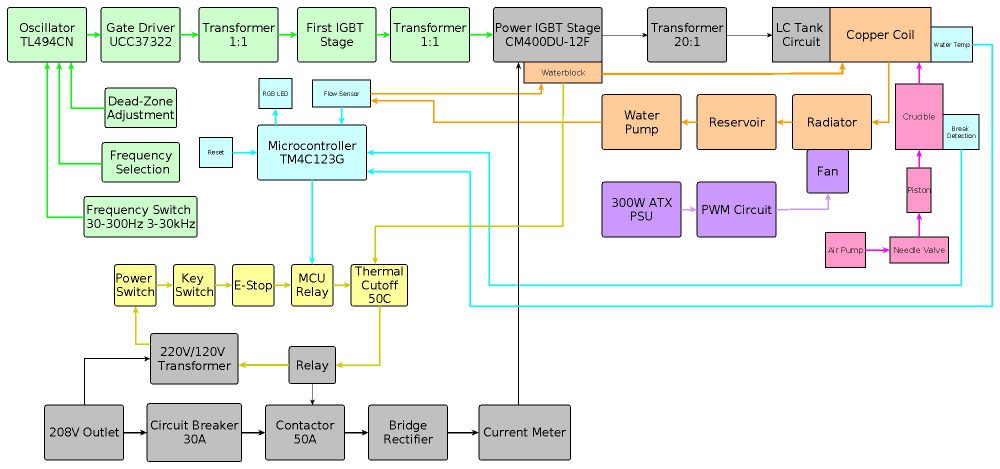*NOTE: This is not a final design yet*
I along with a team started this project in the fall of 2014 and it is almost complete. The goal is to melt aluminum and steel for researching metal alloys. I don’t even know where to begin on this project because there are so many parts and systems. I guess I will start with a block diagram. This design is based off an instructable by Bayley Wang.
The green section is the control electronics which consists of the TL494CN oscillator and subsequent power amplification stages. The frequency that can be output has two ranges, 30-300Hz and 3-30kHz. The thought being that steel will increase the inductance of coil thereby reducing the resonant frequency of the LC tank circuit. This stage has been slightly modified from the original circuit to get rid of resonance in the driver circuitry at around 25kHz. More details about that later.
The grey section consists of the power stage. The input to this is a 208V L-L 120V L-N 3 phase wall outlet. It then goes through a 30A circuit breaker with GFCI protection. The contactor then switches on and off the furnace with a step-down transformer connected to many switches and relays. The 3 phase is then bridge rectified into HVDC. The DC is then converted into an AC signal by CM400DU-12F power IGBTs in a full-bridge configuration. This current drives a 20:1 step down transformer which couples into the LC tank circuit. Finally, the large flux created by 100s of amps in the LC tank circuit creates large currents in the metal leading to high resistive losses, melting it.
The cyan section is the micro-controller monitoring circuit. A Tiva C series launchpad was chosen for this task. This monitors the flow of the coolant, detects if the crucible has broken, the temperature of the coolant and coolant pump. It outputs status indication through an RGB led on the control panel. It also can shut off the furnace if an error is detected. The micro-controller than goes into a stalled state requiring a hard reset.
The orange section is the coolant loop. This provides cooling for the LC tank circuit and the IGBTs. The reservoir is a 3-gallon bucket. The radiator was salvaged out of a small car.
The purple section controls the fan cooling off the radiator. The PWM controller steps the effective voltage down slightly because at 12v the fan was drawing too much current.
The magenta section controls the crucible. An electric bicycle air pump lifts the crucible into the work coil. The crucible is lowered when a needle valve to the atmosphere is opened.
